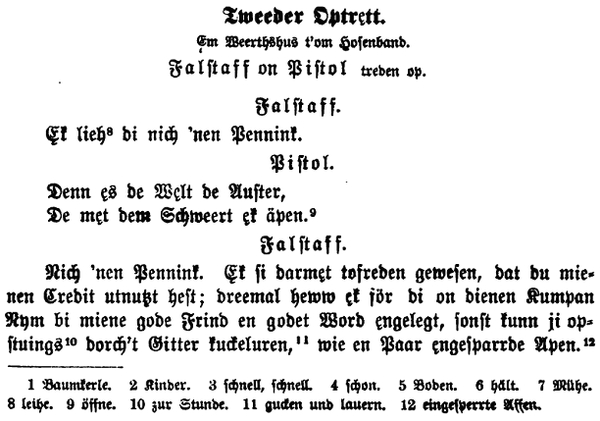Low German
Graphic system
All of the graphic systems that were used to write down Low German dialects used on Polish lands, were a modified Latin alphabet (also the Gothic minuscule). Influences of standard High German, and of more standardized varieties of Low German from Western Germany can be observed. Furthermore, some of the dialects were preserved primarily in notes made by researchers. They used various graphic systems that were created on the basis of phonetic transcription, and rich in diacritics.
Illustration: Low German text printed in Gothic shrift (the text taken from: Shakespeare 1877: 39
 Shakespeare 1877 / komentarz/comment/r /
Shakespeare 1877 / komentarz/comment/r / Shakespeare, William 1877. De lostgen Wiewer von Windsor. Liegnitz: Nehring.
 ).
).
ISO Code
ISO 639-3: Low German - nds, Mennonites' Plautdietsch - pdt; Middle Low German (including the lingua franca variety of the Hanseatic League) - gml.
The Library of Congress MARC 21 standard - NDS.
ISO-639-2: nds.
SIL (14th ed. of The Ethnologue): sxn; presently The Ethnologue uses nds.
The Linguascale (classification developed by L’Observatoire Linguistique) uses several codes for the German varieties used in the past in the present territory of Poland:
- 52-ACB-cg (New-Marchian, Pomeranian from the region of Stettin/Szczecin),
- 52-ACB-ch (most of Pomerania and Prussia),
- 52-ACB-cia (the fragment of Prussia most to the east).
Moreover, the language varieties of the German diaspora:
- 52-ACB-hd (Plautdietsch of Mennonites),
- 52-ACB-hpa (the variety from Esprito Santo, Brazil).
The Library of Congress MARC 21 standard - NDS.
ISO-639-2: nds.
SIL (14th ed. of The Ethnologue): sxn; presently The Ethnologue uses nds.
The Linguascale (classification developed by L’Observatoire Linguistique) uses several codes for the German varieties used in the past in the present territory of Poland:
- 52-ACB-cg (New-Marchian, Pomeranian from the region of Stettin/Szczecin),
- 52-ACB-ch (most of Pomerania and Prussia),
- 52-ACB-cia (the fragment of Prussia most to the east).
Moreover, the language varieties of the German diaspora:
- 52-ACB-hd (Plautdietsch of Mennonites),
- 52-ACB-hpa (the variety from Esprito Santo, Brazil).
- Pomorze Tylne i Prusy Zachodnie
- przyp01
- przyp02
- przyp03
- przyp04
- przyp05
- przyp06
- przyp07
- Adam 1893
- Pinnow 2006b
- Sanders 1982
- Breyer 2006
- Słabig 2009
- Foss 1971
- Putzger 1905
- Zielińska 2012
- Mitzka 1954
- Müller-Baden 1905
- Höhmann i Savedra 2011
- Łopuszańska 2008b
- Jenks i Sarnowsky 2009
- Herrmann-Winter 1995
- Ziesemer 1911
- Turnbull 2011
- Siatkowski 1983
- Holsten 1947
- Winter 1967
- Laabs 1974
- Łopuszańska 2008a
- Steinke 1914
- Laude 1995
- Schemionek 1881
- Dorr 1877
- Shakespeare 1877
- ten Venne 1998
- Debus 1996
- Reifferscheid 1887
- Teuchert 1909
- Teucher 1910
- Oppenheimer 1975
- Mitzka 1928
- Lewis 2009
- Granzow 1982
- Laskowsky i Matthias 1926
- Matthias 1933
- Riemann 1970
- König 1991
- Pinnow 2006a
- Erben 1974
- Collitz 1911
- Jellinghaus 1892
- Scheel 1894
- Vereza i Kuster 2011
- Tressmann 2009
- Lindow 1926
- Hermann-Winter 1995
- Ziesemer 1950
- Gottsched 1736
- Mitzka 1969
- Domansky 1911
- Gotard 2009
- Bogusławski 1900
- Drosihn 1874
- Götze 1922
- Dähnert 1781
- Toby 2000
- Dollinger 1976
- Mitzka 1930
- Zacharias i Neufeld 2003
- de Graaf 2006
- Klassen 2009
- Driedger 1957
- Wiens 2009
- Johnson 1995
- Mannhardt i Thiessen 2007
- Nieuweboer 2000
- Epp 1987
- Wiens 1957
- Moelleken 1987
- Neff 1953
- Mitzka 1955
- Jarczak 1972
- Rykała 2011
- zagrożenie języków / language endangerment
- reklama restauracji w gwarze gdańskiej
- plattdeutsch w Meklemburgii 1
- plattdeutsch w Meklemburgii 2
- Gwary germańskie płn. Polski XX w
- Przesunięcie granicy odmian w Poznańskiem
- Prowincja Posen w 1849 r.
- Nowa Marchia
- Dialekty germańskie Prus
- Lokalizacja wsi menonickich w Prusach ok. 1800 r.
- Młyn w okolicach Wikrowa
- Świątynia menonicka w Elblągu
- Dialekty d.niemieckich w granicach Polski
- Mapa dialektów niemieckich - 1900
- Odmiany językowe na terenie Wolnego Miasta Gdańska
- Odmiany językowe na południowy zachód od Gdańska
- Tekst dolnoniemiecki szryftem gotyckim
- Słownik Dähnerta
- Dom podcieniowy w Steblewie
- Mapa zasięgu językowego Hanzy
- Egzemplarz Barther Bibel
- Biblia z Schottland